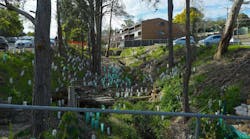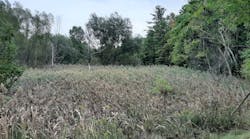Live siltation is a revegetation technique used to secure the toe of a streambank and trap sediment while creating aquatic habitat. The technique utilizes a system of willow installed where it is desirable to encourage deposition and siltation, such as floodplains and inner bends. With additional scour and toe protection (such as stone or log toe protection or rootwad revetments), the technique can be modified for use on outer bends. Live siltation is a very easy and useful technique to implement during construction or while equipment is onsite.
The willow branches provide a roughness element, which slows the water on the streambank side of the system; this reduces lateral movement of the stream and encourages sedimentation. If live cuttings are used, depending on the species, the branches can grow into trees or shrubs, which have a twofold benefit: They provide habitat complexity in the form of shade, and they also form roots, which hold the soil on the bank, thereby providing long-term streambank stability.
Both live and nonliving systems can be installed. For installing a nonliving system, any woody branches can be used. For a live system, willow, cottonwood, or other species that produce adventitious roots may be used. Depending on the region, the branches should be harvested during their dormant season, as the plants’ energy is stored in the stems at that time (as opposed to the leaves); this allows the plant to send energy to the roots when it is planted, instead of wasting energy in keeping the leaves active. As with most biotechnical systems, optimum establishment success is achieved when planting occurs during the dormant season because the water table is higher at that time; this will allow the plants to establish a root system before the dry season hits. Species selection should be based on the most common species found near the area of the installation.
Branches should be 3-5 ft. long, with a minimum diameter of 3/8 in. Side branches can be left on. When harvesting, choose branches that are two to five years old, with smooth bark that is not furrowed. Suckers less than 1/4 in. can be mixed in for roughness but should not be used exclusively, as they do not have sufficient stored energy reserves.
It is critical to keep all cuttings shaded and moist during handling and transportation. The cuttings should be soaked for at least 24 hours and can be stored this way for up to a month.
Soaking stimulates rooting and increases sprouting success. Once cuttings are removed from water, they should be transported immediately to the project site and installed.
Excavate a 2-ft.-deep (minimum), V-shaped trench parallel to the bank at the mean high-water level (for a nonliving system, the trench may be excavated below mean high water during a low-flow period). A good rule of thumb is to place at least 6 in. of the basal end of the pole below or near the seasonal water table. Place willow branches (or other chosen species) in the trench so that one-third of the length of the branches protrudes from the trench and the branches point out toward the stream. A minimum density of six branches per foot should be installed. Once the branches have been placed in the trench, it can be backfilled with soil and gravel and secured with large gravel, carefully placed rocks, bundles, or coir logs.
To reduce washout potential, the upstream and downstream ends of the system should transition smoothly into a stable bank.
